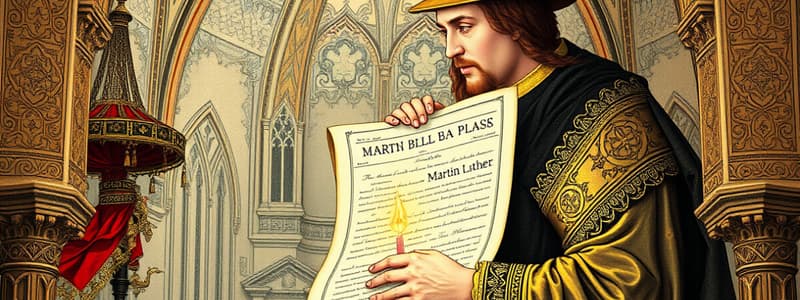Podcast
Questions and Answers
What was the primary purpose of the papal bull issued by Pope Leo X in 1520?
What was the primary purpose of the papal bull issued by Pope Leo X in 1520?
- To support Martin Luther's 95 Theses
- To address dissent against papal authority and indulgences (correct)
- To encourage widespread reform within the Church
- To establish a new Church hierarchy
Which consequence directly resulted from the issuance of the papal bull?
Which consequence directly resulted from the issuance of the papal bull?
- The immediate reform of Church practices
- The establishment of the Protestant Reformation (correct)
- The diminishing influence of Martin Luther
- The reconciliation between Catholic and Protestant factions
What action did Martin Luther take in response to the papal bull?
What action did Martin Luther take in response to the papal bull?
- He withdrew his 95 Theses
- He accepted papal authority
- He established a new Church
- He wrote the 'Assertio omnium articulorum' (correct)
How did the papal bull affect the perception of papal authority?
How did the papal bull affect the perception of papal authority?
Which theological concept was emphasized by Martin Luther in opposition to the Church's teachings?
Which theological concept was emphasized by Martin Luther in opposition to the Church's teachings?
What was a significant impact of the papal bull on the relationship between Catholic and Protestant factions?
What was a significant impact of the papal bull on the relationship between Catholic and Protestant factions?
What did the papal bull highlight regarding individual interpretation of scripture?
What did the papal bull highlight regarding individual interpretation of scripture?
Which of the following doctrines emerged from the discussions prompted by the Reformation?
Which of the following doctrines emerged from the discussions prompted by the Reformation?
Flashcards are hidden until you start studying
Study Notes
Historical Context
- Issued by Pope Leo X in 1520.
- A response to Martin Luther's 95 Theses and criticisms of the Church.
- Aimed to address the growing dissent against papal authority and Church practices, particularly indulgences.
- Occurred during a time of significant religious, political, and social upheaval in Europe, leading to the Protestant Reformation.
Reformation Impact
- Contributed to the polarization between Catholic and Protestant factions.
- Helped establish Luther as a leading figure of the Reformation, solidifying his influence.
- Led to widespread debates about church practices, authority, and the necessity of reform.
- Resulted in the eventual excommunication of Luther in 1521, further entrenching the divide.
Martin Luther's Response
- Luther openly rejected the papal bull, arguing it lacked scriptural foundation.
- Published "Assertio omnium articulorum," outlining his theological positions and critiques of papal authority.
- Emphasized salvation by faith alone, countering the Church's teachings on works and indulgences.
- His defiance galvanized support for the Reformation among various social classes.
Catholic Church Authority
- The bull reinforced the Catholic Church's position on adherence to papal authority.
- Emphasized the notion that deviation from papal edicts threatened the unity and integrity of the Church.
- Highlighted the tension between individual interpretation of scripture and hierarchical Church governance.
- Set the stage for the Catholic Counter-Reformation in response to Protestant critiques.
Theological Implications
- Raised questions about the nature of grace, salvation, and the role of faith versus works.
- Challenged the authority of the Pope as the ultimate interpreter of Christian doctrine.
- Contributed to the development of various Protestant doctrines, such as sola fide (faith alone) and sola scriptura (scripture alone).
- Initiated a broader discourse on the relationship between faith, authority, and individual conscience within Christianity.
Historical Context
- Issued by Pope Leo X in 1520 as a reaction to Martin Luther's 95 Theses and critiques of the Catholic Church.
- Addressed the increasing opposition to papal authority and widespread practices like the sale of indulgences.
- Emerged during a significant period of religious, political, and social turmoil in Europe, known as the Protestant Reformation.
Reformation Impact
- Contributed to the deepening divide between Catholic and Protestant groups.
- Established Martin Luther as a prominent figure in the Reformation, enhancing his influence over the movement.
- Sparked extensive discussions concerning Church practices, authority, and the urgent need for reform within the Church.
- Culminated in Luther's excommunication in 1521, intensifying the rift between the factions.
Martin Luther's Response
- Luther rejected the papal bull, asserting its lack of theological foundation and scriptural basis.
- Released "Assertio omnium articulorum," which detailed his theological beliefs and criticism of papal authority.
- Advocated the principle of salvation by faith alone, opposing the Church's emphasis on good works and indulgences.
- His resistance garnered support from various social classes, fueling the Reformation movement.
Catholic Church Authority
- The bull reinforced the Catholic Church's demand for strict adherence to papal authority.
- Asserted that deviation from papal decrees posed a threat to the Church's unity and integrity.
- Highlighted conflicts between individual scriptural interpretation and the centralized governance of the Church.
- Laid the groundwork for the Catholic Counter-Reformation in response to the challenges posed by Protestantism.
Theological Implications
- Provoked critical questions about grace, salvation, and the balance of faith and works in Christianity.
- Challenged the Pope's authority as the highest interpreter of Christian doctrine, prompting theological shifts.
- Played a crucial role in the formulation of key Protestant tenets such as sola fide (faith alone) and sola scriptura (scripture alone).
- Initiated a broader conversation about the dynamic between faith, authority, and individual conscience within the Christian tradition.
Studying That Suits You
Use AI to generate personalized quizzes and flashcards to suit your learning preferences.




